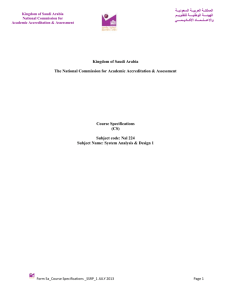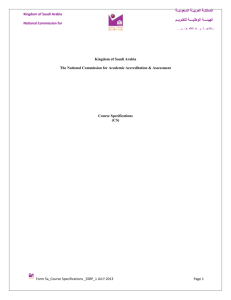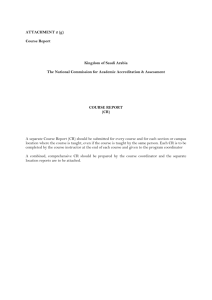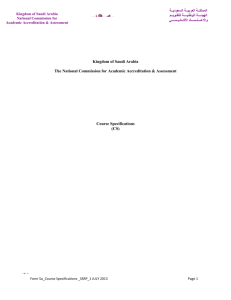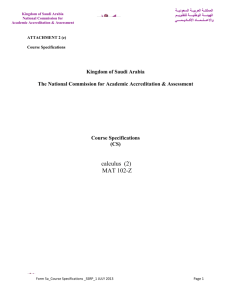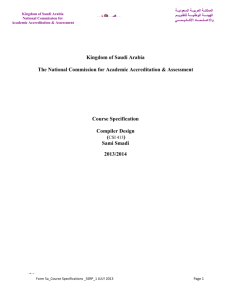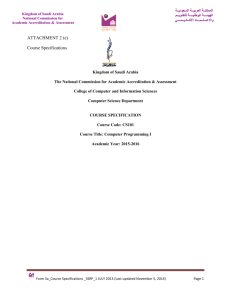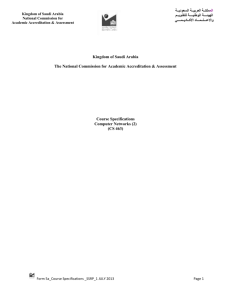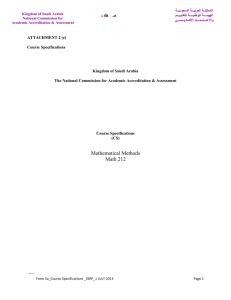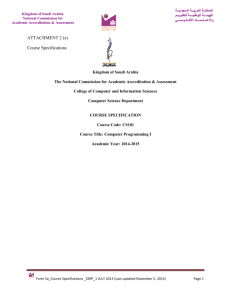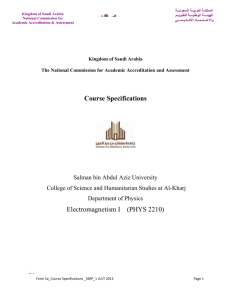ATTACHMENT 2 (e)
advertisement
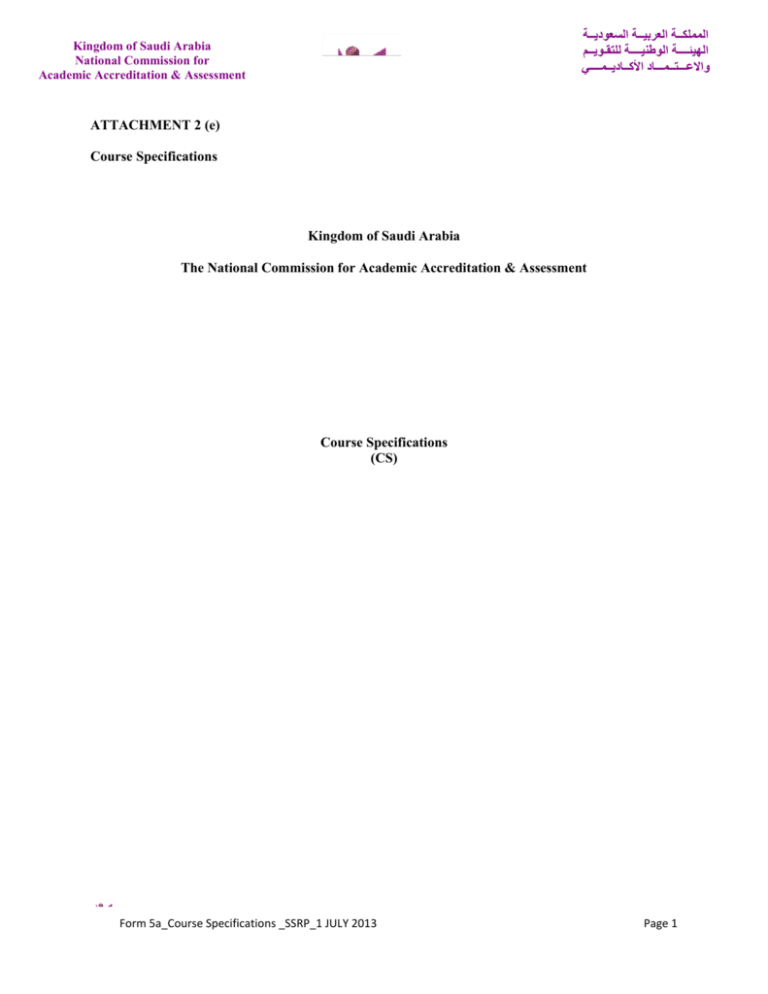
المملكــة العربيــة السعوديــة الهيئــــة الوطنيــــة للتقـويــم واالعـــتــمـــاد األكــاديــمــــي Kingdom of Saudi Arabia National Commission for Academic Accreditation & Assessment ATTACHMENT 2 (e) Course Specifications Kingdom of Saudi Arabia The National Commission for Academic Accreditation & Assessment Course Specifications (CS) Form 5a_Course Specifications _SSRP_1 JULY 2013 Page 1 المملكــة العربيــة السعوديــة الهيئــــة الوطنيــــة للتقـويــم واالعـــتــمـــاد األكــاديــمــــي Kingdom of Saudi Arabia National Commission for Academic Accreditation & Assessment Course Specifications Institution: Salman bin Abdulaziz University Date of Report College: College of Science and Humanity Studies .Department : English A. Course Identification and General Information 1. Course title and code: Phonetics and Phonology 328Eng 2. Credit hours:2 hrs 3. Program(s) in which the course is offered. (If general elective available in many programs indicate this rather than list programs) English 4. Name of faculty member responsible for the course: Dr. Ahmed Benyo 5. Level/year at which this course is offered: 4 6. Pre-requisites for this course (if any) 7. Co-requisites for this course (if any): English Sound Systems 8. Location if not on main campus: Alsulayal 9. Mode of Instruction (mark all that apply) a. Traditional classroom What percentage? b. Blended (traditional and online) What percentage? c. e-learning What percentage? d. Correspondence What percentage? f. Other What percentage? Comments: Form 5a_Course Specifications _SSRP_1 JULY 2013 Page 2 Kingdom of Saudi Arabia National Commission for Academic Accreditation & Assessment Form 5a_Course Specifications _SSRP_1 JULY 2013 المملكــة العربيــة السعوديــة الهيئــــة الوطنيــــة للتقـويــم واالعـــتــمـــاد األكــاديــمــــي Page 3 المملكــة العربيــة السعوديــة الهيئــــة الوطنيــــة للتقـويــم واالعـــتــمـــاد األكــاديــمــــي Kingdom of Saudi Arabia National Commission for Academic Accreditation & Assessment B Objectives 1. What is the main purpose for this course? To get students acquainted with basic concepts of English sounds To utilize students ‘ability to analyze correct and incorrect pronunciation. To assist students to using deduction and induction for understanding sound in context. 2. Briefly describe any plans for developing and improving the course that are being implemented. (e.g. increased use of IT or web based reference material, changes in content as a result of new research in the field) Utilize innovative methods such as co-operative teaching, thinking-based skills. To activate learner’s autonomy, blended learning, and reliance on modern researches. To utilize library resources, CDs and the internet C. Course Description (Note: General description in the form to be used for the Bulletin or handbook should be attached) 1. Topics to be Covered List of Topics No. of Weeks Contact Hours 1, 2, 3, 6 4, 5, 6, 6 7, 8, 9 6 General introduction, Articulators, and Cardinal vowels English short vowels, English long vowels and practical transcription 1st in-term exam, practical transcription and description of English vowels Form 5a_Course Specifications _SSRP_1 JULY 2013 Page 4 المملكــة العربيــة السعوديــة الهيئــــة الوطنيــــة للتقـويــم واالعـــتــمـــاد األكــاديــمــــي Kingdom of Saudi Arabia National Commission for Academic Accreditation & Assessment English diphthongs, descriptions of English consonants and 2nd in-term test Place of articulations, manner of articulation and practical exercises. Form 5a_Course Specifications _SSRP_1 JULY 2013 10, 11, 12 6 13, 14, 15 6 Page 5 المملكــة العربيــة السعوديــة الهيئــــة الوطنيــــة للتقـويــم واالعـــتــمـــاد األكــاديــمــــي Kingdom of Saudi Arabia National Commission for Academic Accreditation & Assessment 2. Course components (total contact hours and credits per semester): Lecture Tutorial Laboratory Practical Other: Total Contact Hours 15 15 Credit 2 30 3. Additional private study/learning hours expected for students per week. 4. Course Learning Outcomes in NQF Domains of Learning and Alignment with Assessment Methods and Teaching Strategy Course Learning Outcomes, Assessment Methods, and Teaching Strategy work together and are aligned. They are joined together as one, coherent, unity that collectively articulate a consistent agreement between student learning, assessment, and teaching. The National Qualification Framework provides five learning domains. Course learning outcomes are required. Normally a course has should not exceed eight learning outcomes which align with one or more of the five learning domains. Some courses have one or more program learning outcomes integrated into the course learning outcomes to demonstrate program learning outcome alignment. The program learning outcome matrix map identifies which program learning outcomes are incorporated into specific courses. On the table below are the five NQF Learning Domains, numbered in the left column. First, insert the suitable and measurable course learning outcomes required in the appropriate learning domains (see suggestions below the table). Second, insert supporting teaching strategies that fit and align with the assessment methods and intended learning outcomes. Third, insert appropriate assessment methods that accurately measure and evaluate the learning outcome. Each course learning outcomes, assessment method, and teaching strategy ought to reasonably fit and flow together as an integrated learning and teaching process. Fourth, if any program learning outcomes are included in the course learning outcomes, place the @ symbol next to it. Every course is not required to include learning outcomes from each domain. Form 5a_Course Specifications _SSRP_1 JULY 2013 Page 6 المملكــة العربيــة السعوديــة الهيئــــة الوطنيــــة للتقـويــم واالعـــتــمـــاد األكــاديــمــــي Kingdom of Saudi Arabia National Commission for Academic Accreditation & Assessment 1.0 1.1 1.2 NQF Learning Domains And Course Learning Outcomes Knowledge To develop students’ ability to grasp pronunciation of English and sound To understand the process of accentuation rhythm and intention. 2.0 Cognitive Skills 2.1 To acquire knowledge of: Phonetics, vowels 2.2 3.0 3.1 Consonants and connected speech Course Teaching Strategies Lectures, either electronic or traditional. Workshops for American and British accents. To activate modern teaching styles such as co-operative teaching, microteaching, and blended teaching. To utilize modern educational media such as the internet, computer and video-conferencing Course Assessment Methods Oral & written exams. Participation & discussion. Classroom participation & discussion. Classroom participation & discussion. Interpersonal Skills & Responsibility Enhancing students skill to be initiated into dialogues & discussions. Form 5a_Course Specifications _SSRP_1 JULY 2013 Providing classroom management so as to reflect the total significance of the syllabus design. Activate participation in classroom as a sign of shouldering responsibility Page 7 المملكــة العربيــة السعوديــة الهيئــــة الوطنيــــة للتقـويــم واالعـــتــمـــاد األكــاديــمــــي Kingdom of Saudi Arabia National Commission for Academic Accreditation & Assessment 3.2 4.0 4.1 4.2 Activating the channel Creating real situations for interpersonal of feedback between skills and shouldering responsibilities. students and teachers. Observe student’s attendance for lectures and office hours. Communication, Information Technology, Numerical Boosting students' ability to use means of technology and their applications. Using computerbased programs and blended teaching. Activating students ability to use the internet for logging on and retrieving information. Activating semiresearch papers and utilizing multimedia and information technology. 5.0 Psychomotor 5.1 5.2 None None Testing student’s ability to use the internet and web sites. Evaluating student’s ability to use exams. None Suggested Guidelines for Learning Outcome Verb, Assessment, and Teaching NQF Learning Domains Suggested Verbs Knowledge Cognitive Skills list, name, record, define, label, outline, state, describe, recall, memorize, reproduce, recognize, record, tell, write estimate, explain, summarize, write, compare, contrast, diagram, subdivide, differentiate, criticize, calculate, analyze, compose, develop, create, prepare, reconstruct, reorganize, summarize, explain, predict, justify, rate, evaluate, plan, design, measure, judge, justify, interpret, appraise Interpersonal Skills & Responsibility demonstrate, judge, choose, illustrate, modify, show, use, appraise, evaluate, justify, analyze, question, and write Communication, Information Technology, Numerical demonstrate, calculate, illustrate, interpret, research, question, operate, appraise, evaluate, assess, and criticize demonstrate, show, illustrate, perform, dramatize, employ, manipulate, Form 5a_Course Specifications _SSRP_1 JULY 2013 Page 8 المملكــة العربيــة السعوديــة الهيئــــة الوطنيــــة للتقـويــم واالعـــتــمـــاد األكــاديــمــــي Kingdom of Saudi Arabia National Commission for Academic Accreditation & Assessment Psychomotor operate, prepare, produce, draw, diagram, examine, construct, assemble, experiment, and reconstruct Form 5a_Course Specifications _SSRP_1 JULY 2013 Page 9 المملكــة العربيــة السعوديــة الهيئــــة الوطنيــــة للتقـويــم واالعـــتــمـــاد األكــاديــمــــي Kingdom of Saudi Arabia National Commission for Academic Accreditation & Assessment Suggested verbs not to use when writing measurable and assessable learning outcomes are as follows: Consider Maintain Maximize Reflect Continue Examine Review Ensure Strengthen Explore Enlarge Encourage Understand Deepen Some of these verbs can be used if tied to specific actions or quantification. Suggested assessment methods and teaching strategies are: According to research and best practices, multiple and continuous assessment methods are required to verify student learning. Current trends incorporate a wide range of rubric assessment tools; including web-based student performance systems that apply rubrics, benchmarks, KPIs, and analysis. Rubrics are especially helpful for qualitative evaluation. Differentiated assessment strategies include: exams, portfolios, long and short essays, log books, analytical reports, individual and group presentations, posters, journals, case studies, lab manuals, video analysis, group reports, lab reports, debates, speeches, learning logs, peer evaluations, self-evaluations, videos, graphs, dramatic performances, tables, demonstrations, graphic organizers, discussion forums, interviews, learning contracts, antidotal notes, artwork, KWL charts, and concept mapping. Differentiated teaching strategies should be selected to align with the curriculum taught, the needs of students, and the intended learning outcomes. Teaching methods include: lecture, debate, small group work, whole group and small group discussion, research activities, lab demonstrations, projects, debates, role playing, case studies, guest speakers, memorization, humor, individual presentation, brainstorming, and a wide variety of hands-on student learning activities. 5. Schedule of Assessment Tasks for Students During the Semester Assessment task (e.g. essay, test, group project, examination, speech, oral presentation, etc.) 1 1st in-term exam Week Due Proportion of Total Assessment 7th week 15% 2 2nd in-term exam 12th week 15% 3 Assignments continued 10% 4 Final exam 16th week 60% 5 6 7 8 Form 5a_Course Specifications _SSRP_1 JULY 2013 Page 10 Kingdom of Saudi Arabia National Commission for Academic Accreditation & Assessment المملكــة العربيــة السعوديــة الهيئــــة الوطنيــــة للتقـويــم واالعـــتــمـــاد األكــاديــمــــي D. Student Academic Counseling and Support 1. Arrangements for availability of faculty and teaching staff for individual student consultations and academic advice. (include amount of time teaching staff are expected to be available each week) Two hours for lectures per week, four offices hours and four academic counseling hours E. Learning Resources 1. List Required Textbooks: Peter Roach. English Phonetics and Phonology. 2. List Essential References Materials (Journals, Reports, etc.) 3. List Recommended Textbooks and Reference Material (Journals, Reports, etc) 4. List Electronic Materials (eg. Web Sites, Social Media, Blackboard, etc.) 5. Other learning material such as computer-based programs/CD, professional standards or regulations and software. F. Facilities Required Indicate requirements for the course including size of classrooms and laboratories (i.e. number of seats in classrooms and laboratories, extent of computer access etc.) 1. Accommodation (Classrooms, laboratories, demonstration rooms/labs, etc.) Form 5a_Course Specifications _SSRP_1 JULY 2013 Page 11 Kingdom of Saudi Arabia National Commission for Academic Accreditation & Assessment المملكــة العربيــة السعوديــة الهيئــــة الوطنيــــة للتقـويــم واالعـــتــمـــاد األكــاديــمــــي 2. Computing resources (AV, data show, Smart Board, software, etc.) 3. Other resources (specify, e.g. if specific laboratory equipment is required, list requirements or attach list) G Course Evaluation and Improvement Processes 1 Strategies for Obtaining Student Feedback on Effectiveness of Teaching In-term formative exams Final summative exam Evaluation exercises 2 Other Strategies for Evaluation of Teaching by the Program/Department Instructor Seminars for model lesson presentation 3 Processes for Improvement of Teaching Training sessions for college members. 4. Processes for Verifying Standards of Student Achievement (e.g. check marking by an independent member teaching staff of a sample of student work, periodic exchange and remarking of tests or a sample of assignments with staff at another institution) Evaluating in-term test and final exam Utilizing normal distribution curves for students performance Form 5a_Course Specifications _SSRP_1 JULY 2013 Page 12 Kingdom of Saudi Arabia National Commission for Academic Accreditation & Assessment Form 5a_Course Specifications _SSRP_1 JULY 2013 المملكــة العربيــة السعوديــة الهيئــــة الوطنيــــة للتقـويــم واالعـــتــمـــاد األكــاديــمــــي Page 13 المملكــة العربيــة السعوديــة الهيئــــة الوطنيــــة للتقـويــم واالعـــتــمـــاد األكــاديــمــــي Kingdom of Saudi Arabia National Commission for Academic Accreditation & Assessment 5 Describe the planning arrangements for periodically reviewing course effectiveness and planning for improvement. Updating course syllabus according to international progress Students evaluations for instructors. Faculty or Teaching Staff: Dr. Ahmed Benyo_______________________________ Signature: _______________________________ Date Report Completed: ____23/11/ 1435____ Received by: _____________________________ Dean/Department Head Signature: _______________________________ Date: _______________ Form 5a_Course Specifications _SSRP_1 JULY 2013 Page 14
